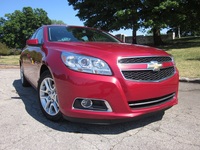2013 Chevrolet Malibu ECO Ride and Review by Larry Nutson +VIDEO
SEE ALSO: Chevrolet Buyers Guide
2013 Chevrolet Malibu ECO
A good thing gets better
by Larry Nutson
Senior Editor, Chicago Bureau
The Auto Channel
The auto industry around the globe spent the last decade bringing electrification into the automobile powertrain. Today we now have pure battery EVs, gasoline-electric hybrids, plug-in hybrids, and from GM the eAssist hybrid. Various powertrain choices in addition to the gasoline or diesel engine are now available for consumers to choose.
Introduced by Buick on the 2012 Regal, GM’s industry-first eAssist is now available on the 2013 Malibu ECO, the first Chevy to use this technology. The Malibu ECO is a mild-hybrid. It combines a 15-kW electric motor and 0.5-kWh lithium-ion battery with a 2.4-liter gasoline engine. The 182HP gas engine is mated to a six-speed automatic. And of course all this new technology is in the name of reduced emission and increased fuel economy.
Watch the 2013 Chevy Malibu promo video
Chevy says the ECO is the most fuel efficient Malibu ever. It has EPA fuel economy ratings of 25 city mpg and 37 highway mpg. Chevy has also said that the non-ECO 2013 Malibu should get over 30 mpg highway. We’ll have to wait for EPA’s numbers. But for a comparison at this time, the 2012 Malibu was rated 22 city mpg and 33 highway mpg.
 |
 |
My driving environment in the week I had the ECO included both in-city Chicago driving and a couple highway drives. The Malibu ECO accelerated smoothly and quite adequately. Highway merging and overtaking was done with ease. Engine operation was smooth and quiet. At the beginning of my driving week the outside temperatures were somewhat moderate and I didn’t need to use the air conditioning. The stop/start system, which shuts off the engine when you come to a stop, activated very often. The engine smoothly and quickly restarts seamlessly. However, later in the week the temps moved up and the air conditioning was needed. With AC on, the stop start system didn’t come in to operation.
 |
The new 2013 Malibu comes in LS, LT and LTZ trim levels, in addition to the ECO. Prices start at $23,150 for the LS and top out at $30,925 for the LTZ. The ECO has a base price of $26,095 and from an equipment comparison standpoint is most similar to the LT model with a base price starting at $24,765. That’s $1330 more for the ECO technology.
 |
On the outside the exterior is quite attractive and very well done. It was a hard task to improve on the outgoing design from 2008 but Chevy’s designers did a nice job. The front has the distinctive Chevy face and the rear carries Camaro-inspired taillights. The interior is very comfortable, well laid out, and roomy. This Malibu is almost 3 inches wider and this makes for pretty comfortable seating for three in the rear.
 |
The non-ECO LS, LT and LTZ model will feature an all-new, fuel-efficient and powerful Ecotec 2.5L four-cylinder engine and next-generation six-speed transmission combination. It’s rated at 197 horsepower. A new Ecotec 2.0L turbo, rated at 259 horsepower, debuts this fall. In addition to the larger trunk these models have an 18.5 gallon fuel tank.
Following a decade of work to electrify cars we’ll spend this decade putting the infrastructure in place to support those that need to be plugged in. Experts say that by the end of the 20-teens we’ll see a spike in the purchase rate of EVs and hybrids of all sorts.
If you’re shopping for a 5-passenger mid size sedan, the good-looking 2013 Malibu deserves a good look.
© Larry Nutson



